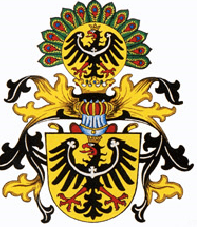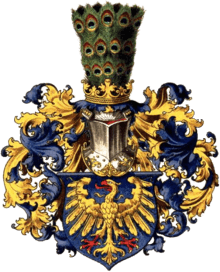Duchies of Silesia
| Duchies of Silesia | ||||||||||||
| Slezská Knížectví (cs) Herzogtümer Schlesien (de) | ||||||||||||
| Crown land of the Bohemian Crown | ||||||||||||
| ||||||||||||
| ||||||||||||
.svg.png) Duchies of Silesia within the Holy Roman Empire (1618) | ||||||||||||
| Capital | Wrocław, Opole, Opava, various others | |||||||||||
| Languages | Czech, Polish, German | |||||||||||
| Religion | Roman Catholic, Utraquist, Lutheran, Moravian Brethren | |||||||||||
| Government | Monarchy | |||||||||||
| King | ||||||||||||
| • | 1335–1378 | Charles IV (first) | ||||||||||
| • | 1916–1918 | Charles III (last) | ||||||||||
| History | ||||||||||||
| • | Joined Kingdom of Bohemia | 1335 | ||||||||||
| • | Austrian Silesia formed | 1742 | ||||||||||
| ||||||||||||
| Today part of | ||||||||||||
The Duchies of Silesia were a crown land of the Bohemian Crown, that were formed when Duchy of Silesia joined the Kingdom of Bohemia in 1335 under the Treaty of Trentschin. The duchies were ruled by the Dukes of Silesia, consisted of the Duchy of Lower Silesia, the Duchy of Upper Silesia and numerous other duchies. Most of Silesia was annexed by the Kingdom of Prussia in 1742; and the Duchy of Teschen, Duchy of Troppau and Duchy of Nysa remained under the control of the Bohemian crown as Austrian Silesia until 1918.
History
Duchy of Silesia (1138–1335)
In the (vain) hope to prevent an inheritance dispute, the Piast prince Bolesław III Wrymouth by his last will and testament had divided Poland into hereditary provinces distributed among his four sons: Masovia, Kujawy, Greater Poland and Silesia. Beside which, the Seniorate Province (Lesser Poland) with the residence of Kraków was reserved for the eldest, who according to the principle of agnatic seniority was to be High Duke of all Poland. This act inadvertently started the process known as Fragmentation of Poland.
Bolesław's son, Władysław II received the Duchy of Silesia and, as the eldest, was also granted the title of a High Duke among with the Seniorate Province. Nevertheless, after he had tried to gain control over all Poland, he was banned and expelled by his younger half-brothers in 1146. Bolesław's second eldest son Bolesław IV the Curly, Duke of Masovia, became Polish High Duke. When, in 1163, Władysław's three sons, backed by Emperor Frederick I Barbarossa returned to Poland, Bolesław IV had to restore their heritage.
After ten years of joint rule, Władysław's sons finally divided Silesia in 1173:
- Bolesław I the Tall, the eldest, received the core territory around the residences of Wrocław, Legnica and Opole. In 1180, he granted the Duchy of Opole to his son Jarosław, who ruled until his death in March 1201. Upon Bolesław's death in December 1201, his lands were inherited by his only remaining son Henry I the Bearded
- Mieszko I Tanglefoot became Duke of Racibórz and received Bytom and Oświęcim in 1177.
- Konrad Spindleshanks (Konrad Laskonogi), the youngest, in 1177 also claimed his rights and received the Duchy of Głogów from his brother Bolesław, who after Konrad's death about 1180/90 again inherited it.
-
 1172/3-1177Bolesław IJarosławMieszko I
1172/3-1177Bolesław IJarosławMieszko I -
 1177-1185Bolesław IJarosławMieszko IKonrad
1177-1185Bolesław IJarosławMieszko IKonrad -
 1185-1201Bolesław IJarosławMieszko I
1185-1201Bolesław IJarosławMieszko I -
 1201-1202Henry IMieszko I
1201-1202Henry IMieszko I
After his brother Bolesław I had died, Miezsko I Tanglefoot also conquered and took the Duchy of Opole from his nephew Henry I the Bearded. He ruled over the Racibórz and Opole duchies, which emerged as Upper Silesia, until his death in 1211. Henry I the Bearded remained sovereign of the Lower Silesian Duchy of Wrocław, he acquired the Greater Polish lands of Kalisz in 1206, which he granted to his Piast cousin Władysław Odonic, as well as Lubusz Land in 1210. High Duke of Poland from 1232, he conquered further Greater Polish territories around Santok in 1234.
Mieszko's heir was Duke Casimir I of Opole, who died in 1230. Thereupon, Henry I managed to reunite whole Silesia under his reign. He was succeeded by his son Henry II the Pious in 1238, while Upper Silesia was inherited by Casimir's son Mieszko II the Fat in 1239. He and his younger brother, Władysław Opolski, had already received Greater Polish Kalisz in 1234.
Henry II was killed at the Battle of Legnica in 1241. His eldest son and heir, Duke Bolesław II the Bald temporarily gave Lubusz Land to his younger brother Mieszko († 1242). He reconciled with his Greater Polish cousin Duke Przemysł I and finally returned Santok in 1247 and remained sole ruler of Lower Silesia until 1248.
Mieszko II the Fat, of Upper Silesia, in 1244, returned Kalisz to Duke Przemysł I of Greater Poland. He died in 1246 and his possessions were inherited by his brother Władysław Opolski.
-
 1206-1217Henry IWładysław OdonicLubusz LandMieszko I,
1206-1217Henry IWładysław OdonicLubusz LandMieszko I,
1211: Casimir I -
 1217-1230Henry ICasimir I
1217-1230Henry ICasimir I -
 1241-1243Bolesław IIMieszko LubuskiWładysław OpolskiMieszko II
1241-1243Bolesław IIMieszko LubuskiWładysław OpolskiMieszko II -
 1243-1248Bolesław IIWładysław OpolskiMieszko II,
1243-1248Bolesław IIWładysław OpolskiMieszko II,
1246: Władysław
OpolskiSantokKaliszKępnoLelów
Lands of the Bohemian Crown (1335–1918)
Duchies of Silesia in Holy Roman Empire (1335–1742)
Silesia was subsequently divided among the descendants and successors of the Piast dynasty, until they died out in 1675. Those Silesian Piasts, known as Dukes of Silesia, and territories they ruled were known as Duchies of Silesia.
Many of the Duchies shared similar fate: falling away from Kingdom of Poland sphere of influence, vassalization by John I of Bohemia in 1327, and under suzerainty of the Kingdom of Bohemia by the Treaties of Trentschin and Visegrád in 1335. After the Piasts had become extinct, the duchies were "State Countries" of the Bohemian Crown, which fell to the House of Habsburg in 1526. In 1742, most of Silesia was annexed by the Kingdom of Prussia following the First Silesian War.
Duchies of Silesia in Habsburg Empire (1742–1918)
Duchies of Silesia
- Note: this list may not be complete.
- Duchy of Bielsko (Bílské knížectví, Księstwo Bielskie, Herzogtum Bielitz)
- Duchy of Brzeg (Knížectví Břeh, Księstwo Brzeskie, Herzogtum Brieg)
- Duchy of Bytom (Knížectví Bytomské, Księstwo Bytomskie, Herzogtum Beuthen)
- Duchy of Głogów ( Knížectví Hlohovské, Księstwo Głogowskie, Herzogtum Glogau)
- Duchy of Głubczyce (Knížectví Hlubčice, Księstwo Głubczyckie, Herzogtum Leobschütz)
- Duchy of Jawor (Javorské knížectví, Księstwo Jaworskie, Herzogtum Jauer)
- Duchy of Krnov (Krnovské knížectví, Księstwo Karniowskie, Herzogtum Jägerndorf)
- Duchy of Legnica (Lehnické knížectví, Księstwo Legnickie, Herzogtum Liegnitz)
- Duchy of Münsterberg (Minstrberské knížectví,Księstwo Ziębickie, Herzogtum Münsterberg)
- Duchy of Nysa (Niské knížectví, Księstwo Nyskie, Herzogtum Neisse)
- Duchy of Oleśnica (Olešnické knížectví, Księstwo Oleśnickie, Herzogtum Oels)
- Duchy of Opole (Opolské knížectví, Księstwo Opolskie, Herzogtum Oppeln)
- Duchy of Oświęcim (Osvětimské knížectví, Księstwo Oświęcimskie, Herzogtum Auschwitz)
- Duchy of Pszczyna (Pštinské knížectví, Księstwo Pszczyńskie, Herzogtum Pless)
- Duchy of Racibórz (Ratibořské knížectví, Księstwo Raciborskie, Herzogtum Ratibor)
- Duchy of Siewierz (Seveřské knížectví, Księstwo Siewierskie, Herzogtum Siewierz)
- Duchy of Świdnica (Svídnické knížectví, Księstwo Świdnickie, Herzogtum Schweidnitz)
- Duchy of Teschen (Księstwo Cieszyńskie, Knížectví těšínské, Herzogtum Teschen)
- Duchy of Troppau (Vévodství opavské,' Księstwo Opawskie, Herzogtum Troppau)
- Duchy of Wrocław (Vratislavské knížectví, Księstwo Wrocławskie, Herzogtum Breslau)
- Duchy of Zator (Zatorské knížectví, Księstwo Zatorskie, Herzogtum Zator)
- Duchy of Żagań (Zaháňské knížectví, Księstwo Żagańskie, Herzogtum Sagan)
There were also other little duchies: Bernstadt, Buchwald, Coschok, Cosel, Crossen, Falkenberg, Freistadt, Freudenthal, Gleiwitz, Goldberg, Grottkau, Grünberg, Hainau, Hirschberg, Loslau, Löwenberg, Lüben, Namslau, Ohlau, Parchwiz, Rybnik, Sprottau, Steinau, Strehlitz, Tost, Wohlau, and combination duchies: Duchy of Opole and Racibórz
Bibliography
- ŽÁČEK, Rudolf. Dějiny Slezska v datech. Praha : Libri, 2003. ISBN 80-7277-172-8.



